List of Contents
Automotive Catalytic Converter Market Size and Forecast 2025 to 2034
The global automotive catalytic converter market size was estimated at USD 169.50 billion in 2024 and is projected to reach around USD 387.84 billion by 2034, expanding at a CAGR of 8.63% from 2025 to 2034. The rising inclination towards environmentally friendly mobility solutions drives the growth of the automotive catalytic converter market.
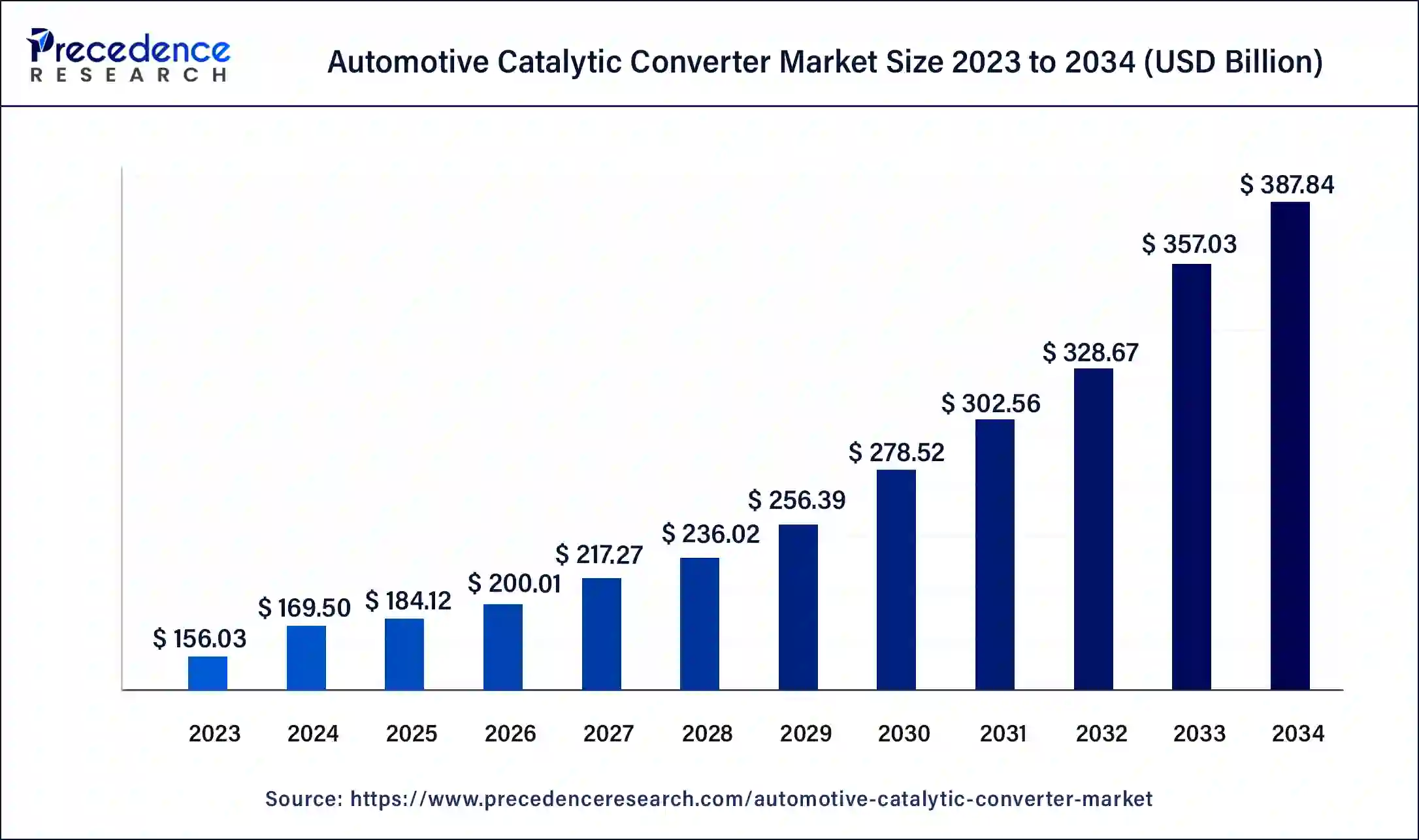
Automotive Catalytic Converter Market Key Takeaways
- The global automotive catalytic converter market was valued at USD 169.50 billion in 2024.
- It is projected to reach USD 387.84 billion by 2034.
- The automotive catalytic converter market is expected to grow at a CAGR of 8.63% from 2025 to 2034.
- Europe dominated the automotive catalytic converter market with the largest market share of 35% in 2024.
- Asia Pacific is expected to expand at a solid CAGR of 12.72% during the forecast period.
- By product, the three-way oxidation-reduction segment has contributed more than 49% of the market share in 2024.
- By product, the two-way oxidation segment is expected to grow at a notable CAGR of 10.62% during the forecast period.
- By material, the palladium segment has captured the largest market share of 53% in 2024.
- By material, the platinum segment is expected to grow at a solid CAGR of 6.83% during the anticipated period.
Europe Automotive Catalytic Converter Market Size and Growth 2025 to 2034
The Europe automotive catalytic converter market size was exhibited at USD 59.33 billion in 2024 and is projected to be worth around USD 137.68 billion by 2034, poised to grow at a CAGR of 8.78% from 2025 to 2034.
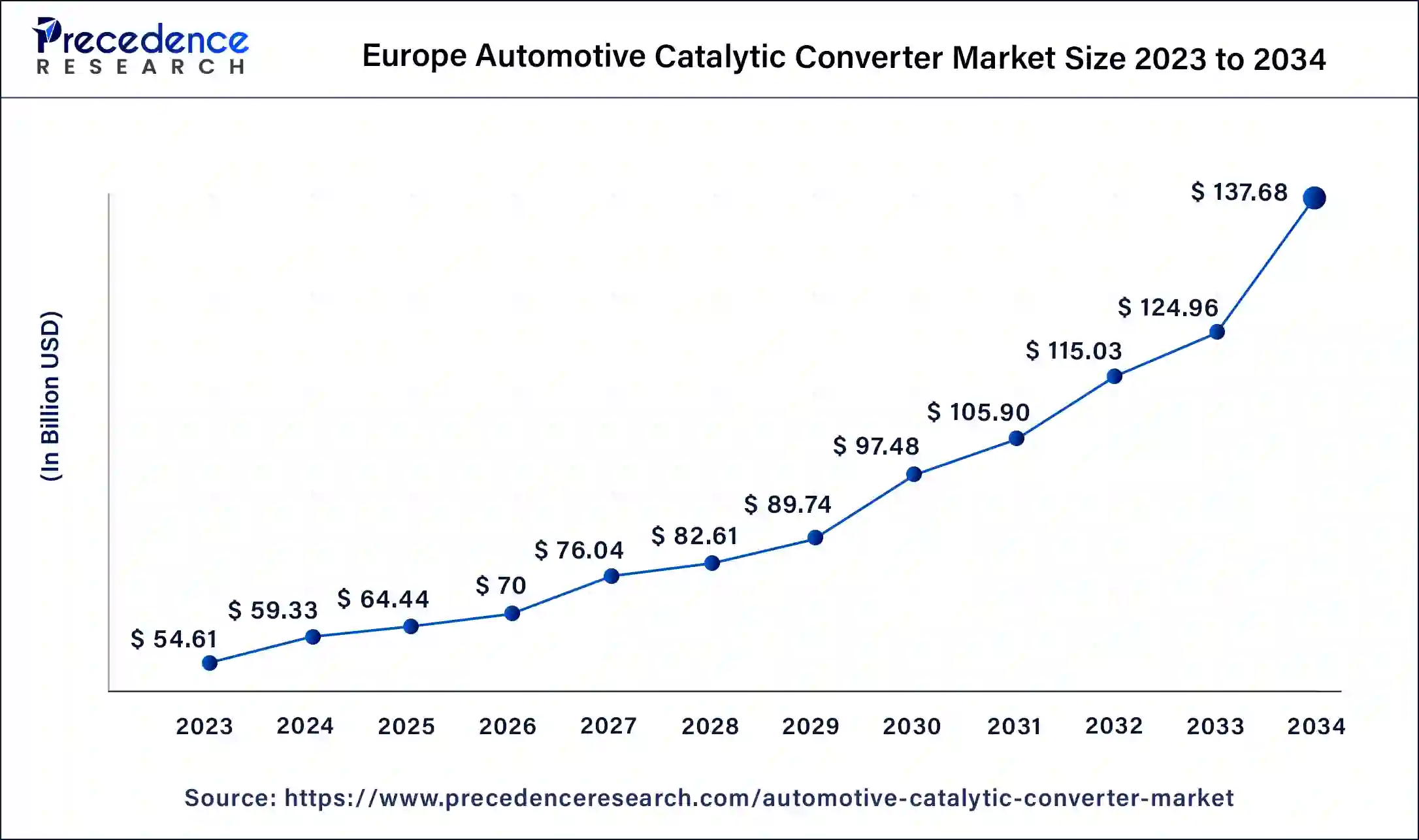
Europe dominated the market with the largest market share in 2024. The growth of the market in the region is attributed to the rising awareness about carbon emission in the environment by the rising number of automobiles on the road that is driving the demand for efficient technologies that help in reducing the carbon emission from vehicles, which boosts the growth of the automotive catalytic converter system. The rising government interventions for implementing supportive regulations for maintaining environmental safety are boosting the growth of the automotive catalytic converter system market across the region.
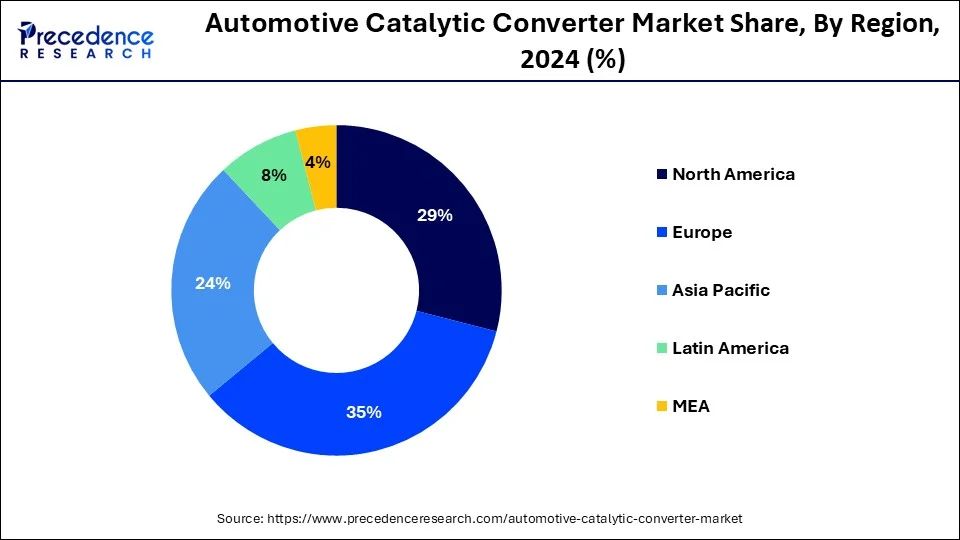
Asia Pacific is expected to have the fastest growth during the forecast period. The growth of the market in the region is attributed to the rising population of the regional countries, and the growing number of vehicles is causing a higher percentage of carbon emission in the environment that causes severe problems in the environment and human life, driving the demand for the catalytic converter system in the automobiles for maintaining and reducing the carbon emission is accelerating the growth of the automotive catalytic converter market in the region.
Market Overview
The catalytic converter is one of the essential parts of the automobile and the automobile manufacturing process. It plays a significant role in the vehicle's exhaust system. The catalytic converter helps reduce the emission of harmful toxic pollution into the environment and converts it into substances like carbon dioxide and water vapors. The catalytic converter exposes harmful fumes to the metals and chemicals inside the converter for chemical reactions, which helps them transform harmful gases into substances like water vapors and carbon dioxide.
It is an essential component in the automobile that helps convert harmful gases into less harmful substances before releasing them into the environment or air. There are two main types of automotive catalytic converters: two- and three-way catalytic converters. The catalytic converter is made from some specific types of metal like palladium, platinum, or rhodium. The catalytic converter plays an important role in enhancing and maintaining the performance of vehicles and helps reduce atmospheric pollution. It makes the automobile more environmentally friendly. Thus, the rising concern about the environment and human health due to rising environmental pollution drives the growth of the automotive catalytic converter market.
Automotive Catalytic Converter Market Growth Factors
- The rising global population, the increasing disposable income in the population, and the shifting lifestyle preferences are driving the demand for the automobile industry that is anticipated to drive the demand for the automotive catalytic converter market.
- The increasing awareness about the environmental population of gasoline vehicles that cause severe issues in human health and the environment is driving the demand for efficient technology that can reduce carbon emissions from vehicles and drive the demand for catalytic converters in the automotive industry.
- The rising population, the increasing demand for passenger cars the increasing trend for owning one's own mobility solution that drives the growth in the sales of automobiles, and the rising market competition in the automobile industry are driving the demand for automotive catalytic converter market.
- The increasing intervention of the regional government and the imposed regularities in environmental pollution control are limiting the automotive exhaust for every vehicle. Thus, automobile manufacturers are accepting the catalytic converter in the vehicle to reduce carbon emissions, which drives the demand for the automotive catalytic converter market.
- The rising penetration of technologies into the automobile and the ongoing research and development activities in the manufacturing process, technology integration, and environmental solutions are driving the growth of the automotive catalytic converter market.
Automotive Catalytic Converter Market Scope
| Report Coverage | Details |
| Market Size by 2034 | USD 387.84 Billion |
| Market Size in 2025 | USD 184.12 Billion |
| Market Size in 2024 | USD 169.50 Billion |
| Market Growth Rate from 2025 to 2034 | CAGR of 8.63% |
| Largest Market | Europe |
| Base Year | 2024 |
| Forecast Period | 2025 to 2034 |
| Segments Covered | Product, Material, and Regions |
| Regions Covered | North America, Europe, Asia-Pacific, Latin America, and Middle East & Africa |
Market Dynamics
Driver
Rising environmental and human health concerns
The growing population and the rising number of vehicles on the road are among the major reasons for carbon emissions and other harmful gases in the environment that have a severe impact on human health and the environment. Heavy environmental pollution causes severe health impacts, as it is the major cause of chronic diseases such as skin diseases, asthma, bronchitis, and other respiratory diseases.
The continuous rise in global warming due to vehicles emitting carbon into the environment drives the adoption of catalytic converters in automobiles. Additionally, the increasingly stringent regulation for limiting the vehicle population is forcing automobile manufacturers to adopt the catalytic converter to reduce carbon emissions from vehicles, which is also contributing to the growth of the automotive catalytic converter market.
The rising demand for catalytic converters from diesel-based vehicles is propelling the growth of the market. Diesel-based vehicles emit harmful gases in the environment, such as NOx and CO2 particles. Two types of catalytic converters are in higher demand from diesel vehicle manufacturers, including Lean NOx-Trap (LNT) and Selective Catalytic Reduction (SCR).
- The passenger vehicle emits approximately 400 grams of CO2 per mile. And 4.6 metric tons of carbon dioxide every year. An average gasoline vehicle on the road has a fuel economy of 22.2 miles per gallon and a driving range of around 11,500 miles every year. Every gallon creates 8,887 grams of carbon dioxide.
- As per the Vehicle Pollution Forum, Melbourne Climate Futures Academy researchers Dr. Kelvin Say and Ms. Clare Walter said in the new research on vehicle emissions in Australia, there are about 11,105 premature deaths in adults per year. There are 6840 patients with respiratory illness hospitalized per year. There are 12,210 cardiovascular hospitalizations every year and 66,000 active patients with asthma cases per year.
Restraint
Rising adoption of EV (electric vehicles)
Rising environmental pollution and the increasing trend towards electric vehicle batteries are limiting the adoption of catalytic converters, and the increasing number of industry leaders shifting towards the manufacturing of battery electric vehicles is restraining the growth of the automotive catalytic converter market.
Opportunity
Rising competition in the automobile industry
The rising competition among automobile manufacturers globally is driving the opportunity for growth in the automotive catalytic converter market. The rising investment in technological advancements in the automobile and the catalytic converter development is accelerating the demand for the market. Additionally, the rising partnership between the component manufacturer and vehicle manufacturer is driving the growth of the market. The increasing consumer awareness about environmental pollution tends to the higher demand for vehicles that generate less pollution, which boosts the growth of the adoption of the catalytic converter by the major industry leaders, which is fueling the growth of the market.
Product Insights
The three-way oxidation-reduction segment dominated the automotive catalytic converter market in 2024. The growth of the segment is attributed to the higher capacity of emission control, which drives the adoption of the three-way oxidation-reduction segment. The three-way oxidation-reduction is the main technology in the automotive catalytic converter to control carbon emissions such as gasoline, liquefied petroleum gas (LPG), and natural gas in the environment that causes severe negative impacts on the human body.
The three-way oxidation-reduction catalytic used the closed-loop system, including oxygen sensors and lambda, for regulating the airflow into the gasoline engine. The catalyst uses metallic or ceramic substances with an active coating, including ceria, alumina, and other oxide combination metals like palladium, platinum, and rhodium.
The two-way oxidation segment is expected to grow fastest during the forecast period. The rising adoption of gasoline-powered vehicles is driving the demand for two-way oxidation catalysts, which are cost-effective solutions for gasoline vehicles. The rising demand for gasoline vehicles in developing and developed countries due to the rising awareness about carbon emissions is driving the demand for the segment in the automotive catalytic converter market.
Material Insights
The palladium segment captured the largest market share in 2024. The growth of the segment is attributed to the rising adoption of the palladium catalytic converter due to its increased capacity to minimize the harmful emissions from petroleum engine vehicles. The increasing demand for the palladium catalytic converter from the automobile industry.
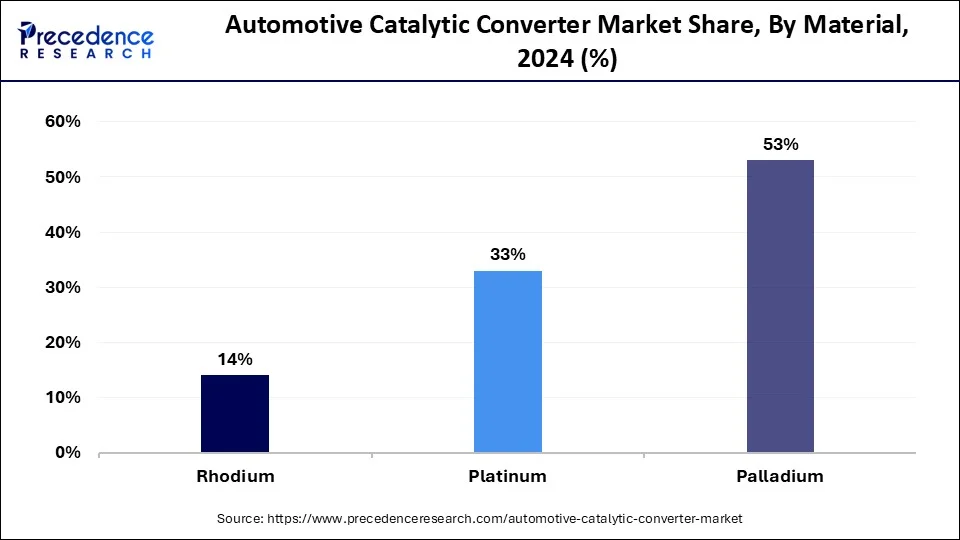
The palladium plays an important role in the automobile industry. Palladium is highly capable of neutralizing toxic pollutants by turning them into water vapor and carbon dioxide. The major portion of palladium is used by the automotive industry for the manufacturing of catalytic converters to reduce carbon monoxide, hydrocarbons, and other harmful gases from exhaust emissions.
The platinum segment is expected to grow significantly in the market during the anticipated period. The increasing demand for the platinum catalytic converter from the automobile industry due to its good oxidation catalyst and higher resistance to phosphorus, sulfur, and lead.
Automotive Catalytic Converter Market Companies
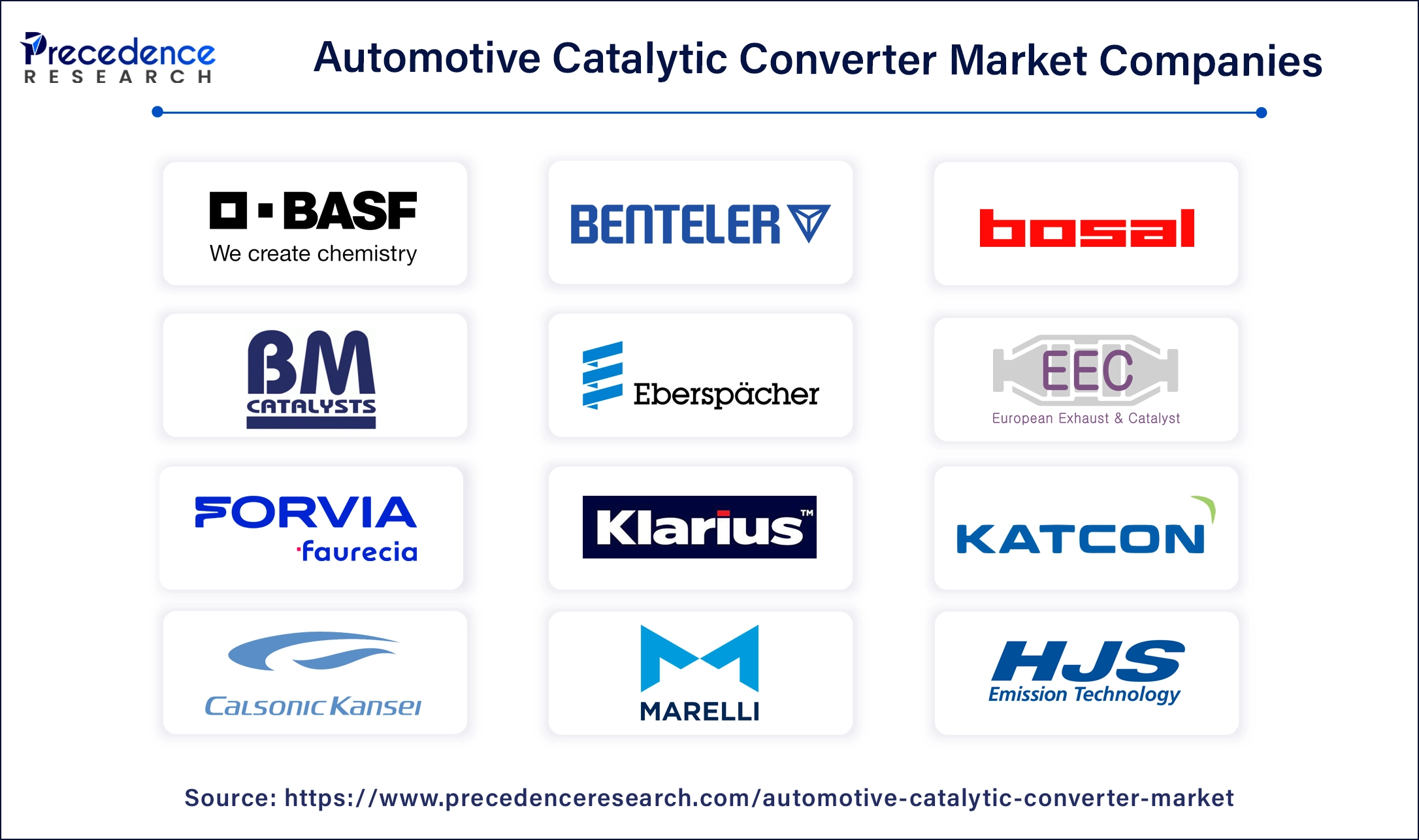
- Marelli Corporation
- Calsonic Kansei
- Deccats
- Eberspächer
- European Exhaust & Catalyst Ltd
- FORVIA Faurecia
- BASF SE
- BENTELER International Aktiengesellschaft
- BM Catalysts Limited
- BOSAL
- HJS Emission Technology GmbH & Co. KG
- Jetex Exhausts Ltd
- Katcon SA de CV
- Klarius Products Ltd
- Marelli Holdings Co., Ltd.
- Tenneco, Inc.
Recent Developments
- In July 2024, Laser Photonics Corporation, a major provider of the industrial developer of laser systems for cleaning and other material processing applications, launched the MarkStar Handheld VIN and extended its MarkStar product range for engraving systems and laser marking.
- In January 2024, the BASF, the chemical group, and Heraeus, the precious metal converter and manufacturer of the two German companies, launched the BASF Heraeus Metal Resource (BHMR), a new joint venture in China. The company works for a plant recovering precious metals from automotive catalytic converters in Pinghu, south of Shanghai.
- In January 2024, Elphinstone launched the E15 model in the Elphinstone Underground Hard Rock Support Vehicle range. The letter E represents Elphinstone, and 15 represents the nominal capacity in metric tonnes.
- In February 2023, Renault, a major European brand in India, updated the overall line, including TRIBER, KIGER, and KWID, to update with the new BS-VI Step 2 emission norms with enhanced safety features.
Segments Covered in the Report
By Product
- Two-Way Oxidation
- Three-Way Oxidation-Reduction
- Diesel Oxidation Catalyst
By Material
- Platinum
- Palladium
- Rhodium
By Geography
- North America
- Asia Pacific
- Europe
- Latin America
- Middle East & Africa
For inquiries regarding discounts, bulk purchases, or customization requests, please contact us at sales@precedenceresearch.com
Frequently Asked Questions
Ask For Sample
No cookie-cutter, only authentic analysis – take the 1st step to become a Precedence Research client